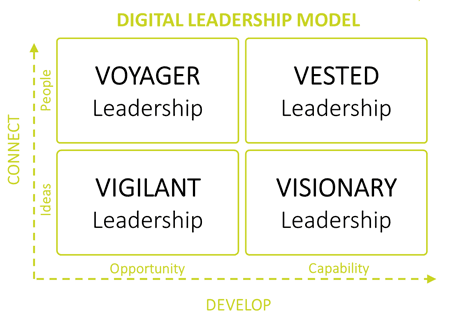You can't lead a digital transformation alone

By Stijn Viaene
Professor of Digital Transformation
The success of your digital transformation depends on the agility of your organisation. You need to constantly evaluate opportunities and take action, preferably faster than your competitors. This is where the leadership challenges lie. Together with his team, Professor Stijn Viaene has developed a leadership model and a game, the Digital Transformation Leaders Game. This is a light-hearted way of gaining insights into the different types of leadership which contribute to the success of your digital transformation.
Four types of leadership
“If the digital transformation is to succeed,” begins Stijn, “it must have the support of everyone in the organisation. Digital transformation is rather like turning a tanker; it's not something that can be achieved by a mere handful of people, let alone one individual. Our model therefore regards leadership as the connection and mobilisation of people and ideas in order to detect opportunities and make the most of them.”
The Digital Leadership Model, or 4V model, distinguishes between four types of leadership:
- Vigilant: leaders who take on this role are trying to navigate their way through turbulent times of digital disruption. They are constantly scanning the environment, including far beyond the boundaries of their organisation or sector, looking for ideas and opportunities.
- Voyager: this type of leadership succeeds in tapping into the creativity of individuals and teams, turning abstract opportunities into concrete solutions through experimentation.
- Visionary: leaders who take on this role paint a convincing and ambitious picture of a successful digital company. They make sure that everyone in the organisation feels as if they are striving towards a common goal.
- Vested: this type of leadership actually puts the entire organisation, like a well-oiled machine, on the path to successful digital transformation.
Leadership is a team effort
Stijn emphasises that this isn't about leadership styles. “Our model defines a specific type of leadership as a set of behaviours. It’s what you do that determines the type of leadership you demonstrate and the leadership role you adopt. As a result, it has nothing to do with personality styles or with introvert or extrovert leaders.”
He follows: “Each type can't be traced back to a single individual either, but stems from close collaboration between a group of people who are spread across the organisation. Of course you can be good at more than one role, but I've never met anyone who could combine all four.”
Nothing beats experience
The model is accompanied by a game. Why? “We are constantly looking for new and more effective ways to teach theoretical concepts and models,” answers Stijn. “We now know that gamification leads to the faster and better absorption of knowledge. So while you can explain these kinds of models, which we do, during the game the participants actually get to experience what we mean in practice.”
Three rounds
The game revolves around the digital transformation of a fictitious bank and consists of three rounds. The participants are divided into small groups, each with their own assignment or project – developing a specific app, setting up the bank branch of the future, outlining the IT strategy etc. At the end of the journey, all these projects must naturally fit together.
“In the first round, we throw the participants in at the deep end,” says Stijn. “Under time pressure, they have to make all kinds of decisions while being faced with unexpected events on a regular basis. They soon realise that coordinating these initiatives is no easy task. The second round is a moment of reflection. We touch on a sore point: if you aren't tackling the transformation in an integrated way, end-to-end, then you're not actually transforming at all. We show how the various roles in the model can solve the problems which they encountered during the first round. Finally, during the third round they experience how it feels to assimilate these four roles and collaborate, instead of rushing forward blindly and tackling problems on their own, predictable though it may seem.”
For anyone who feels the calling
The half-day course really gets to the essence of a successful digital transformation. A huge achievement, and Stijn is rightly proud of this new formula.
So who is this course intended for exactly? “The model reveals the answer,” he says. “For anyone who wants to play a pioneering role, in any department and at any level in the organisation – it's for managers and non-managers alike. After all, leadership is behaviour and in this model it is separated from your position or hierarchical responsibilities. It's about what you do, not what's on your card.”
Ready to put things into practice
Will the participants actually be able to put things into practice after this half-day course? “Definitely,” confirms Stijn. “Not only will they understand the model, they will also be able translate it into the context of their own organisation. In addition, they will be able to profile themselves and their colleagues as one or more of the four types. And, not unimportantly, they will be able to enter into ‘coalitions’. As we already mentioned, these four leadership roles will ideally comprise different people (spread across the company) who collaborate, learning while doing and sharing best practices. So yes, even after half a day they will be ready to put the model into practice.”
Not a blank slate
“The good thing about our model is that you can apply it without turning your whole organisation upside down – precisely because we have freed leadership from its traditional place in the organisation,” concludes Stijn. “We apply an extra ‘layer’ on top of the existing structures, as it were. And as long as you put enough weight on it, this extra layer can break through the silos.”
How did our participants experience the Digital Transformation Leaders Game? Oliver Regidor, Digital Transformation Programme Manager at Argenta: Elisabeth Østreng, consulting engineer at Statnett, the Norwegian TSO: Bram Mommers, Global Director Digital Asset Lifecycle at Arcadis: |
Get in touch!



